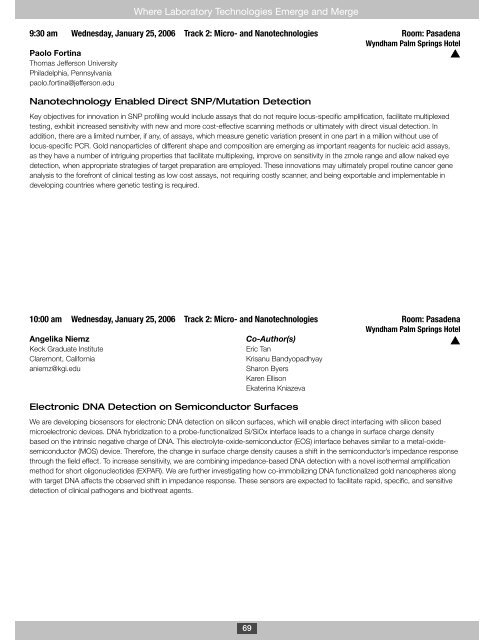LabAutomation 2006 - SLAS
LabAutomation 2006 - SLAS
LabAutomation 2006 - SLAS
Create successful ePaper yourself
Turn your PDF publications into a flip-book with our unique Google optimized e-Paper software.
Where Laboratory Technologies Emerge and Merge<br />
9:30 am Wednesday, January 25, <strong>2006</strong> Track 2: Micro- and Nanotechnologies Room: Pasadena<br />
Wyndham Palm Springs Hotel<br />
Paolo Fortina<br />
Thomas Jefferson University<br />
Philadelphia, Pennsylvania<br />
paolo.fortina@jefferson.edu<br />
Nanotechnology Enabled Direct SNP/Mutation Detection<br />
Key objectives for innovation in SNP profiling would include assays that do not require locus-specific amplification, facilitate multiplexed<br />
testing, exhibit increased sensitivity with new and more cost-effective scanning methods or ultimately with direct visual detection. In<br />
addition, there are a limited number, if any, of assays, which measure genetic variation present in one part in a million without use of<br />
locus-specific PCR. Gold nanoparticles of different shape and composition are emerging as important reagents for nucleic acid assays,<br />
as they have a number of intriguing properties that facilitate multiplexing, improve on sensitivity in the zmole range and allow naked eye<br />
detection, when appropriate strategies of target preparation are employed. These innovations may ultimately propel routine cancer gene<br />
analysis to the forefront of clinical testing as low cost assays, not requiring costly scanner, and being exportable and implementable in<br />
developing countries where genetic testing is required.<br />
10:00 am Wednesday, January 25, <strong>2006</strong> Track 2: Micro- and Nanotechnologies Room: Pasadena<br />
Wyndham Palm Springs Hotel<br />
Angelika Niemz<br />
Co-Author(s)<br />
Keck Graduate Institute<br />
Eric Tan<br />
Claremont, California<br />
Krisanu Bandyopadhyay<br />
aniemz@kgi.edu<br />
Sharon Byers<br />
Karen Ellison<br />
Ekaterina Kniazeva<br />
Electronic DNA Detection on Semiconductor Surfaces<br />
We are developing biosensors for electronic DNA detection on silicon surfaces, which will enable direct interfacing with silicon based<br />
microelectronic devices. DNA hybridization to a probe-functionalized Si/SiOx interface leads to a change in surface charge density<br />
based on the intrinsic negative charge of DNA. This electrolyte-oxide-semiconductor (EOS) interface behaves similar to a metal-oxidesemiconductor<br />
(MOS) device. Therefore, the change in surface charge density causes a shift in the semiconductor’s impedance response<br />
through the field effect. To increase sensitivity, we are combining impedance-based DNA detection with a novel isothermal amplification<br />
method for short oligonucleotides (EXPAR). We are further investigating how co-immobilizing DNA functionalized gold nanospheres along<br />
with target DNA affects the observed shift in impedance response. These sensors are expected to facilitate rapid, specific, and sensitive<br />
detection of clinical pathogens and biothreat agents.<br />
69
















